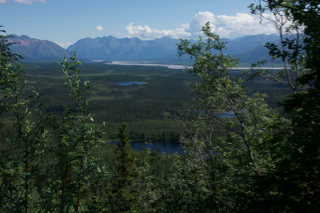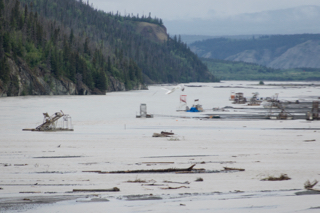 |
| Tombstone Valley, the Dempster Highway |
After hearing rumors of fires and road closures for weeks, we stopped at the Visitor's Center in Dawson City to check on road conditions. The Dempster was open. When we asked about the fires, the young lady said there may still be some smoke around KM marker 280, but that the fire was mostly out. She encouraged us to travel the road, saying the road was open all the way to Inuvik.
We didn't think to ask how big the fire was. We later learned that the aggressive blaze had begun with a lightening strike. It scorched over 325,000 acres. We traveled over twenty-five miles of road charred on either side from the enormous fire. We saw several still-smoldering plumes wafting from the remains of ghostly, blackened trees. Road crews were vigilant, traversing up and down hot spots. At the viewing platform on Olgivie Ridge, all we could see was the charred remains of boreal forests and high tundra grasses. This fire had been devastating.
 |
| Dempster boreal forest fire 2017 |
 |
| 2017 Dempster fire from Olgivie Ridge |
 |
| Black bear grazing on Dempster Highway |
As we neared the Yukon/Northwest Territory border, we were shocked to see a large herd of caribou grazing in the distant meadow. It was the wrong time of year to see these magnificent animals, particularly in such great numbers. Normally this area is their winter feeding grounds. Perhaps the fire had driven them down from the high country.
We were also shocked to see hunters... dozens of them. We couldn't believe hunting would be allowed in July. Through binoculars, we could see several hunters field dressing their kill.
 |
| Caribou on the Dempster in July |
He shook his head. His voice contained sadness. He said it was a rare gift to have caribou in the valley in the summer. The people should not be hunting... they didn't need the meat now. They should let the caribou settle in and become comfortable. He told us that the tribe had sent elders to speak with the hunters and try to dissuade them.
In this part of Canada, the local Gwich'in tribes regulate the hunting season. This man was obviously one of the elders and was distraught over the turn of events.
It was still early in the afternoon. Hoping to see more animals, we made the decision to drive all the way to Inuvik. Perhaps we would see black bear in the Delta. There were none.
We arrived at Jak Provincial Park around six that evening and set up camp in misty rain. By the time we had showers, the clouds parted, and the sun reappeared.
The town of Inuvik sits above the Arctic Circle, and we were obviously still in the land of the midnight sun. I took this photo from inside the camper at 2:30 in the morning. The sun didn't quite set. It simply skirted the horizon for a bit before rising again.
 |
| A Dempster sunset... 2:30 am in July |
We decided to turn around and drive back south. When we arrived again at the border, we saw several trucks and men but no hunters. Perhaps these were the elders sent to discourage hunters. It was hard to believe that we had been here just 24 hours earlier and the place had been buzzing with activity. Now it appeared desolate. The caribou herd had vanished. Using his binoculars, David scoured the horizon for signs of life. Off in the very far distance, he spied a grizzly bear, probably grazing a gut pile from a caribou kill. We camped at Rock Springs, with plans to drive back to the border next morning. Surely we would see animals. We didn't. Even the elders were gone.
We felt disheartened. Everything seemed different on the Dempster this trip. We made the decision to leave the next morning.
 |
| On the Dempster Highway, between Tombstone and Two Moose Lake |
Our last night on the Dempster, we camped in a favorite spot near a field of fireweed. Fireweed is so named because in a temperate forest, it is the first plant to colonize after a fire.
Surely, these flowers were a good omen. We will plan another trip up the Dempster, perhaps even returning next fall. Our prayer is that the fireweed will grow, and the Dempster and its animals will continue to thrive.
 |
| Fireweed on the Dempster Highway |




















































